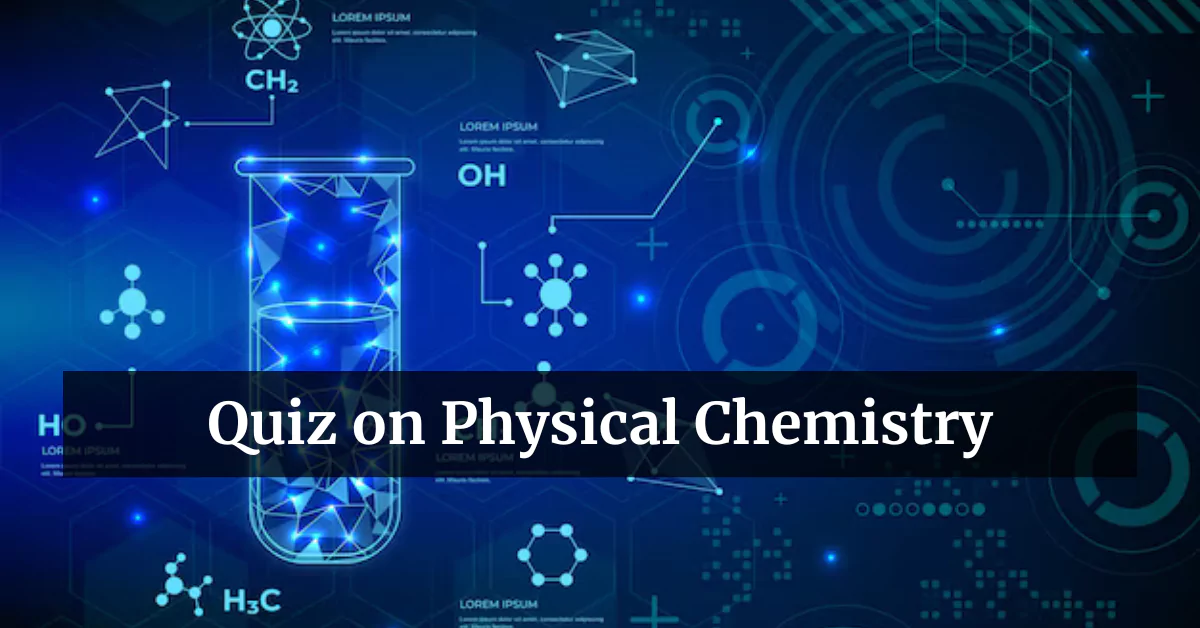NEET UG 2025: This set of 25 advanced-level objective questions from Physical Chemistry is designed specifically for NEET UG 2025 aspirants, covering critical topics such as Thermodynamics, Chemical Equilibrium, Chemical Kinetics, Electrochemistry, Solutions, and Atomic Structure. These challenging questions aim to evaluate students’ in-depth understanding, analytical skills, and problem-solving abilities, helping them prepare effectively for the competitive exam.
1. For an ideal gas undergoing isothermal expansion, which of the following is correct?
(a) ΔU > 0
(b) ΔH > 0
(c) ΔU = 0
(d) ΔH < 0
2. The entropy of a perfectly crystalline substance at absolute zero temperature is:
(a) Maximum
(b) Negative
(c) Zero
(d) Undefined
3. Which quantity remains constant during an adiabatic expansion of an ideal gas?
(a) Temperature
(b) Internal energy
(c) Entropy
(d) Pressure
4. If ΔG for a reaction is negative, then:
(a) ΔH > 0 and ΔS > 0
(b) ΔH < 0 and ΔS < 0
(c) The reaction is spontaneous
(d) The reaction is non-spontaneous
5. An exothermic reaction with negative entropy change will be spontaneous at:
(a) All temperatures
(b) No temperatures
(c) High temperatures only
(d) Low temperatures only
6. For the equilibrium: PCl5⇌PCl3+Cl2PCl_5 \rightleftharpoons PCl_3 + Cl_2PCl5⇌PCl3+Cl2, increasing pressure will:
(a) Increase PCl₃ concentration
(b) Decrease PCl₅ concentration
(c) Shift equilibrium left
(d) Shift equilibrium right
7. The ionic product of water increases with:
(a) Increase in temperature
(b) Decrease in temperature
(c) Adding a base
(d) Adding an acid
8. A buffer solution has equal concentration of salt and acid. If Ka = 10⁻⁵, the pH is:
(a) 5
(b) 7
(c) 9
(d) 3
9. The solubility product (Ksp) of a sparingly soluble salt AB₂ is expressed as:
(a) S²
(b) 4S³
(c) 27S⁴
(d) S³
10. Which statement is true for chemical equilibrium?
(a) ΔG = 0
(b) ΔH = 0
(c) ΔS = 0
(d) ΔG > 0
11. For a first-order reaction, half-life (t₁/₂) is:
(a) Independent of concentration
(b) Directly proportional to initial concentration
(c) Inversely proportional to concentration
(d) Dependent on temperature only
12. Rate constant k has units of mol⁻¹ L s⁻¹. The order of reaction is:
(a) 0
(b) 1
(c) 2
(d) 3
13. Activation energy of a reaction is:
(a) Independent of temperature
(b) Directly proportional to temperature
(c) Inversely proportional to rate constant
(d) Always negative
14. Which plot gives a straight line for a zero-order reaction?
(a) ln[A] vs time
(b) [A] vs time
(c) 1/[A] vs time
(d) log[A] vs time
15. For the reaction A→BA \rightarrow BA→B, doubling concentration of A doubles the rate. Order of reaction is:
(a) Zero
(b) First
(c) Second
(d) Third
16. The emf of a galvanic cell becomes zero when:
(a) Reaction reaches equilibrium
(b) Temperature is increased
(c) Cell is short-circuited
(d) Concentrations are equal
17. Standard hydrogen electrode (SHE) potential is defined as:
(a) 1 V
(b) 0 V
(c) 0.1 V
(d) –1 V
18. Conductivity of electrolytic solution depends on:
(a) Nature of electrolyte
(b) Temperature
(c) Concentration
(d) All of these
19. The equivalent conductance at infinite dilution is highest for:
(a) NaCl
(b) KCl
(c) CsCl
(d) LiCl
20. Faraday’s first law of electrolysis relates mass deposited at electrode directly to:
(a) Voltage applied
(b) Time of electrolysis
(c) Nature of electrolyte
(d) Resistance of solution
21. Which colligative property is most sensitive for molecular mass determination?
(a) Osmotic pressure
(b) Boiling point elevation
(c) Freezing point depression
(d) Vapour pressure lowering
22. Van’t Hoff factor (i) for Al₂(SO₄)₃ in dilute aqueous solution is:
(a) 2
(b) 5
(c) 4
(d) 1
23. The azeotropic mixture of ethanol-water shows:
(a) Ideal behavior
(b) Positive deviation from Raoult’s law
(c) Negative deviation from Raoult’s law
(d) Zero deviation from Raoult’s law
24. Which of the following ions has the highest ionic radius?
(a) Li⁺
(b) Be²⁺
(c) F⁻
(d) Na⁺
25. Among the following, the molecule with zero dipole moment is:
(a) NH₃
(b) BF₃
(c) NF₃
(d) H₂O
✅ Answer Key:
1.(c), 2.(c), 3.(c), 4.(c), 5.(d), 6.(c), 7.(a), 8.(a), 9.(b), 10.(a), 11.(a), 12.(c), 13.(a), 14.(b), 15.(b), 16.(a), 17.(b), 18.(d), 19.(c), 20.(b), 21.(a), 22.(b), 23.(b), 24.(c), 25.(b)
Share your quiz scores in the comments section, and our experts will review your performance to provide personalized tips to help you improve your NEET score.
These questions are crafted to assess students’ deep conceptual understanding, analytical ability, and application of principles in Physical Chemistry for NEET UG 2025.


